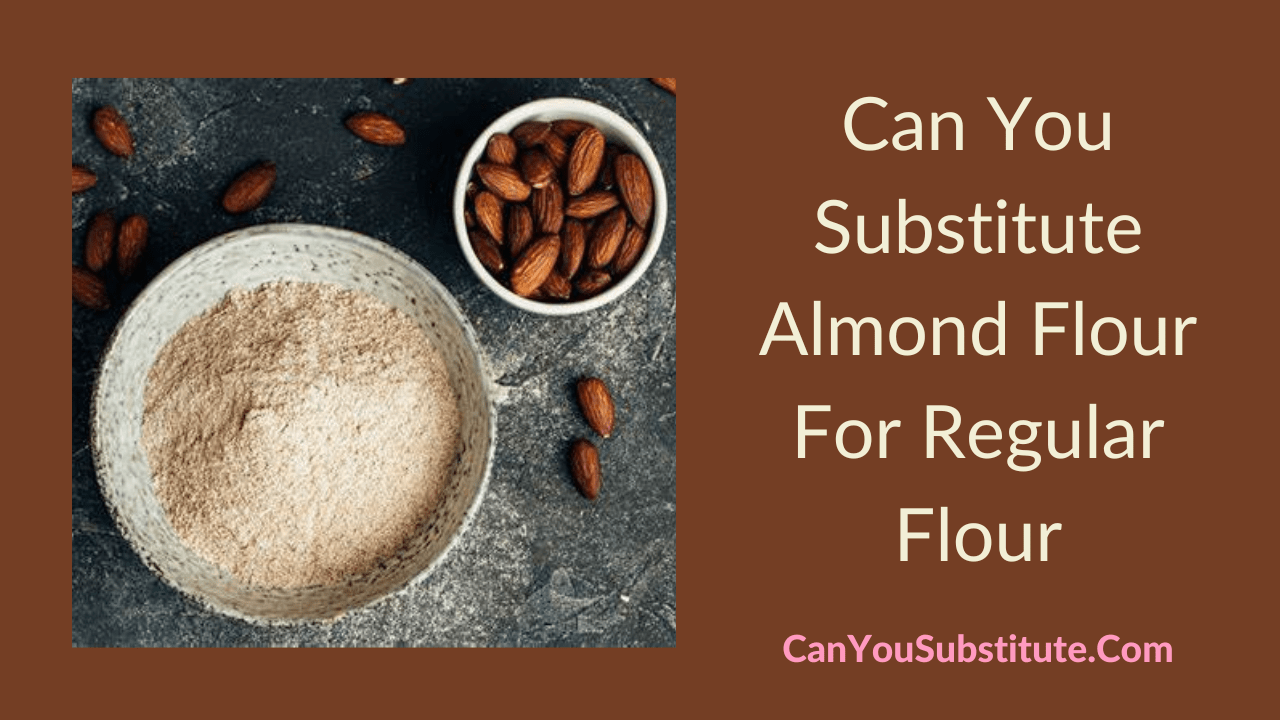Can You Substitute Almond Flour For Regular Flour?: Do you want to begin your life by taking gluten-free food for a healthy lifestyle? Are you planning to bake a cake and realized that you don't have enough amount of flour to use?
Then our guide is the best solution to your issues. Because we have covered detailed information on How can you Substitute Almond Flour For Regular Flour because almond flour is gluten-free flour and it is the best substitute for all-purpose flour.
So, dive into this page & clear your doubts in no time.

What is Almond Flour?
Almond flour is a gluten-free, grain-free, and low-carbohydrate flour that is completely different from regular and other milled flour. Almond flour is produced from finely ground and blanched almonds.
You can see two variations of almond flour with skin and without skin. The taste of the almond flour is slightly nutty but it is a great option for substituting with other flour for people who do dieting.
Almond flour made from blanched almonds contains high sources of magnesium, vitamin E, calcium, potassium, and monounsaturated fats that help in reducing cholesterol.
You can replace regular flour with almond flour while baking gluten-free goods and traditional dessert recipes such as french macarons.
Apart from almond flour, there are a few more gluten-free flour like cassava flour, oat flour, coconut flour, buckwheat flour, and cashew flour. You can use the ground-almond flour as a substitute for almond butter and breadcrumbs.
The lifespan of almond butter is up to 6 months in the refrigerator and less than those months on the pantry shelf.
What is All-Purpose Flour or Regular Flour?
Regular or all-purpose flour is a neutral-flavored flour that was made from the endosperm of soft and hard wheat breeds. White flour and all-purpose flour are the other names for regular flour.
It is a gluten flour and low protein flour compared with other milled flour. All-purpose flour is rich in carbohydrates and grains so it is used for the recipes like cakes, quick bread, chocolate chip cookies, pie crusts, muffins, and brownies.
Not only baked goods, some other recipes such as sauces and gravies use regular flour to thicken the recipe. Moreover, it can also act as a substitute for breadcrumbs because it is a famous base for dredging chicken or fish, or potatoes for deep-frying or frying.
The shelf time for regular flour is 6 months in the pantry and 12 months in the refrigerator.
Can You Substitute Almond Flour For Regular Flour? | Can I Substitute Almond Flour for All-Purpose Flour in Muffins?
Yes, almond flour can be used as a substitute for regular or white flour in baking and other recipes. But swapping both flours on a one-to-one, measure-for-measure, or cup-for-cup ratio can't be worked for wheat or gluten-free flour.
If you're a beginner to deal with this almond flour substitution then memorizing some of the tips will work great while baking. So, here are a few tips to bake with almond flour instead of all-purpose flour.
- Measure well
- Try to add less flour at the beginning
- Bake cookies and brownies with almond flour
- Avoid baking cakes and bread with it
- Add a binder
- Cool in the pan
To get clarity on How much almond flour should be substituted for all-purpose flour, please have a glance at the below module.
How To Replace Regular Flour with Almond Flour?
When replacing your regular flour with almond flour then substituting the right quantity of flour plays a major role in giving the final product as traditional ones.
So, remember to start with the 1:1 substitution ratio at first, later on, follow the texture and consistency you need for the specific recipe and add more flour for the correct batter or dough.
Mostly, many recipes call for the direct replacement of one-to-one substitution. On the other hand, almond flour is a gluten-free flour so it doesn't bind well without the gluten substitute.
So be prepared with the extra egg whites to bind together and desire for getting a stiff batter. When you use a 1:1 flour ratio then you would require many eggs in the recipe.
The goodness in almond flour is the moisture content that keeps your baked goods moist and soft. However it comes with a downside too, due to this extra moisture in the recipe, you may see mold growth.
So, store it in an airtight container and preserve it with extra care. Do Check Other Guides:
Almond Flour Conversion Chart
The conversion chart on almond flour will make you understand the ratios to be replaced with other flour like coconut flour, oat flour, all-purpose flour, etc. With the help of this handy chart, you can easily convert almond flour with other flour and get the perfect results. 
Does Almond flour taste like Regular flour?
Obviously no, both have a different taste in a milder way. Almond flour taste like a bit of nutty flavor or almond flavor. Regular flour or white flour tastes like ground wheat as it is neutral flour.
So, you will get a different taste when you bake with almond flour. If it is absolutely okay for you then blindly use almond flour instead of regular flour. Similar Posts on Food Substitutions:
FAQs on Can I Use Almond Flour Instead of Regular Flour in a Cake or Muffins Recipe?
Key Takeaways
Now, we know that almond flour and regular flour are used interchangeably. So follow the points recommended above on how can you substitute almond flour for regular flour and enjoy baked goods or other recipes when you run out of all-purpose flour.
Are you wondering what can you substitute for eggs with almond flour while baking? Go with the link provided here and also visit our main website @canyousubstitute.com for more such food substitution articles.